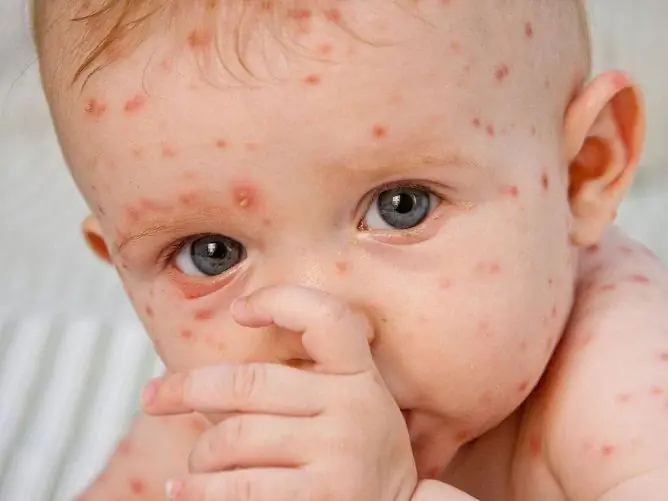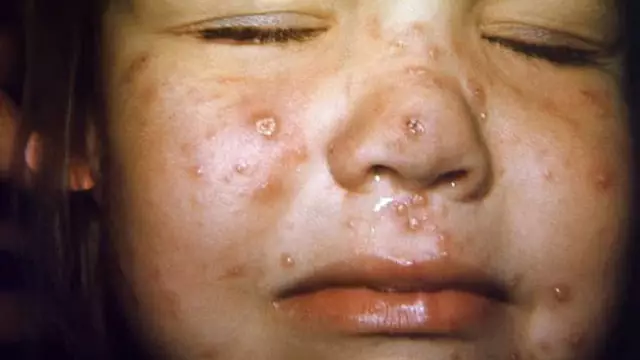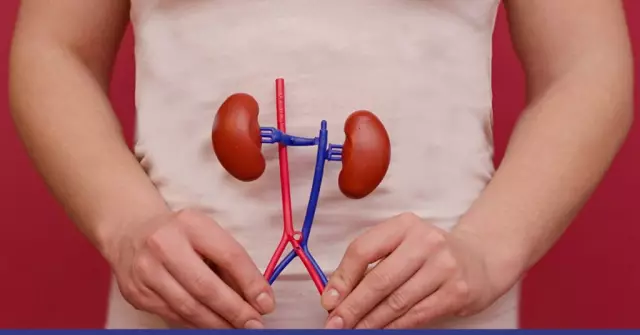- Author Rachel Wainwright [email protected].
- Public 2023-12-15 07:39.
- Last modified 2025-11-02 20:14.
Complications after chickenpox in a child
The content of the article:
-
The consequences of chickenpox in children: how great is the danger
Risk group
-
What are the complications of chickenpox in children?
- Bacterial skin and soft tissue infections
- Chickenpox pneumonia
- Damage to the nervous system
-
What to do
- Etiotropic treatment
- Symptomatic treatment
- Video
Chickenpox (chickenpox) is an acute infectious disease caused by the varicella zoster virus. Chickenpox is widespread among the population, mainly preschool children (from one to 4-5 years old), both boys and girls, are ill. Chickenpox is considered a mild disease, but with the development of complications, a lethal outcome is possible, which is often underestimated. Complications after chickenpox in a child include damage to the nervous tissue, respiratory system and the addition of a bacterial infection.

Complications after chickenpox are more common in children with weakened immunity, as well as in older children
The consequences of chickenpox in children: how great is the danger
In the overwhelming majority of cases, children easily tolerate the disease, the outcome is favorable, and complete recovery occurs. But in rare cases, the disease is severe (bullous, gangrenous, hemorrhagic) or leads to the development of complications. The most dangerous complications include encephalitis, pneumonia, bacterial skin infection, and septic conditions. The incidence of complications with chickenpox is approximately 0.5%. Thus, the chickenpox virus is dangerous to the human body, and the disease can be fatal.
Risk group
A complicated course with chickenpox occurs mainly in children with weakened immunity.
The presence of the following conditions in a child can be attributed to the risk group:
- HIV infection;
- taking glucocorticosteroids to treat other diseases;
- immunosuppressive therapy after organ transplant;
- oncological diseases;
- chronic kidney disease (glomerulonephritis, renal failure);
- allergic pathology (atopic dermatitis);
- rheumatological diseases.
What are the complications of chickenpox in children?
All complications that arise after a previous illness are divided into two groups:
- Specific - caused by the action of the causative agent of the disease (varicella-zoster virus).
- Nonspecific - arise when the bacterial flora is attached.
The division of consequences into specific and non-specific is important for determining treatment tactics.
Depending on the localization, complications from the internal organs, skin and soft tissues, the nervous system, and the respiratory system are isolated.
| Localization | Description | Nosology |
| Skin and soft tissues |
Damage to the skin and soft tissues after chickenpox occurs most often, accounting for about 25% of all complications. Inflammation of the skin and soft tissues is a non-specific complication. What bacteria can cause purulent inflammation: Staphylococcus aureus (most often); · Gram-negative enterobacteria; · Anaerobes; Streptococcus pyogenes (in severe cases). Combined flora quite often takes place. Purulent inflammation of the skin and soft tissues can lead to sepsis. |
Abscess, phlegmon (necrotizing fasciitis), bullous streptoderma, erysipelas, pyoderma, cellulitis, lymphadenitis. |
| Nervous system |
Complications from the nervous system are specific. The central nervous system (CNS) is more often affected, less often the peripheral. A lesion of the cerebellum in the form of cerebellitis is specific for chickenpox, but other structures of the brain may also be involved in the pathological process. Damage to the peripheral nervous system occurs in the form of nerve inflammation, which is manifested by motor and sensory disorders. |
Cerebellitis, encephalitis, serous meningitis, meningoencephalitis, transverse myelitis, paresis and paralysis of the facial nerve, optic neuritis, neuropathy. |
| Respiratory system |
The pathology of the respiratory system is most often caused by the action of the varicella-zoster virus. Less commonly, the cause is the attachment of bacterial flora. The larynx, trachea, bronchi, and lungs may be affected. |
Pharyngitis, stenosing laryngitis, laryngotracheitis, laryngotracheobronchitis, chickenpox pneumonia, bacterial pneumonia. |
| Other organs | Damage to the heart, ENT organs, eyes, musculoskeletal system can also occur. | Myocarditis, purulent otitis media, purulent conjunctivitis, keratitis, panophthalmitis, arthritis. |
Bacterial skin and soft tissue infections
The most common reason for the development of bacterial lesions of the skin and subcutaneous fat is scratching of the itchy elements of the rash. Bacteria enter through damaged areas of the skin.
An early sign of a bacterial skin infection is redness at the base of fresh vesicles. The following symptoms will help to suspect a purulent skin lesion:
- repeated increase in body temperature (without rashes);
- purulent contents inside the vesicles;
- soreness to touch.
More severe is the occurrence of necrotizing fasciitis - an infectious disease that leads to necrosis of the subcutaneous tissue. Necrotizing fasciitis develops mainly during the recovery period. Characterized by redness of the skin, an increase in the volume of the affected limb due to edema, intense pain.
Attention! Photo of shocking content.
Click on the link to view.
Chickenpox pneumonia
Chickenpox pneumonia is relatively rare (about 1%), but is characterized by a severe course. Lung inflammation usually occurs 3-5 days after the rash appears.
Chickenpox pneumonia is characterized by:
- a sharp increase in temperature, not associated with the appearance of a rash;
- shortness of breath, which increases with exercise;
- moist cough;
- pallor of the skin;
- in severe cases, hemoptysis;
- chest pain that is worse when breathing.
Damage to the nervous system
The varicella-zoster virus has tropism not only for the skin, but also for nerve cells, which is why the nervous tissue in chickenpox is most often affected.
In most cases, symptoms of CNS damage develop during the first 7 days, less often in the second week of the disease.
The most dangerous consequence of chickenpox is encephalitis - inflammation of the brain.
How encephalitis manifests itself:
- fever;
- cerebral symptoms - lethargy, headache, hypersensitivity to stimuli (sounds, bright light, touch), vomiting;
- coordination disorders - a wobbly gait, instability;
- speech disorder;
- convulsions.
With meningitis, cerebral symptoms come to the fore (severe headache, vomiting, hyperesthesia, in young children - a constant cry), the development of focal symptoms is not typical.
What to do
If you suspect complications, you should definitely consult a doctor. In most cases, immediate hospitalization is required; home treatment is not carried out.
Etiotropic treatment
Etiotropic treatment consists in the use of medications that affect the causative agents of the disease. Antiviral drugs or antibacterial agents may be used.
Antiviral drugs are prescribed for the treatment of specific complications (chickenpox pneumonia, serous meningitis, encephalitis). Antiherpetic drugs are used, for example, Acyclovir, Vidarabine.
Antibiotics are prescribed for the treatment of bacterial diseases (abscess, phlegmon, bacterial pneumonia, purulent keratitis). Penicillins (Augmentin), macrolides (Erythromycin, Azithromycin), cephalosporins (Ceftriaxone) are used.
Symptomatic treatment
An equally important role is given to symptomatic treatment, which is aimed at combating symptoms. Shows the implementation of detoxification measures (infusion therapy), the introduction of multivitamins. With damage to the central nervous system, glucocorticosteroids are administered.
Video
We offer for viewing a video on the topic of the article.

Anna Kozlova Medical journalist About the author
Education: Rostov State Medical University, specialty "General Medicine".
Found a mistake in the text? Select it and press Ctrl + Enter.






